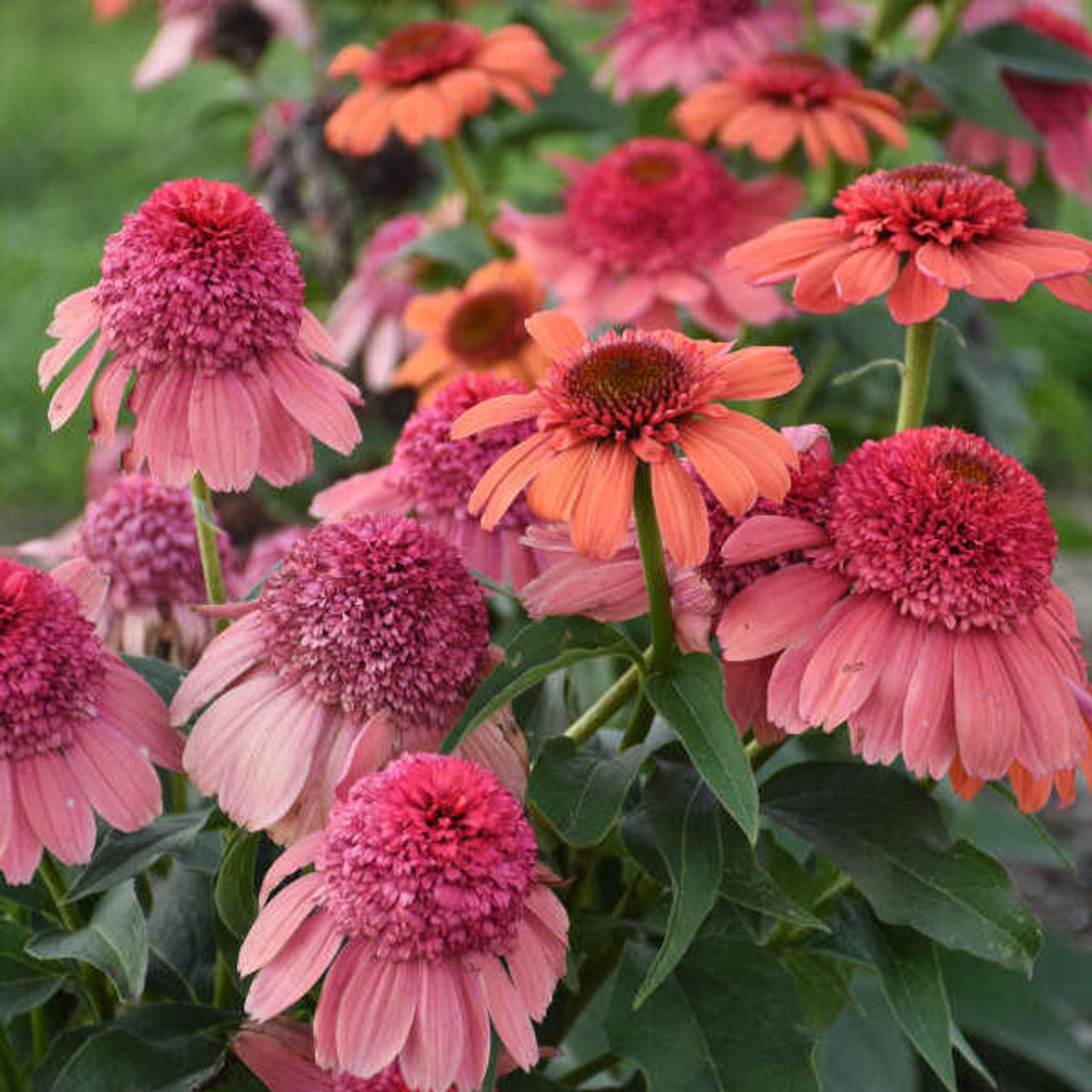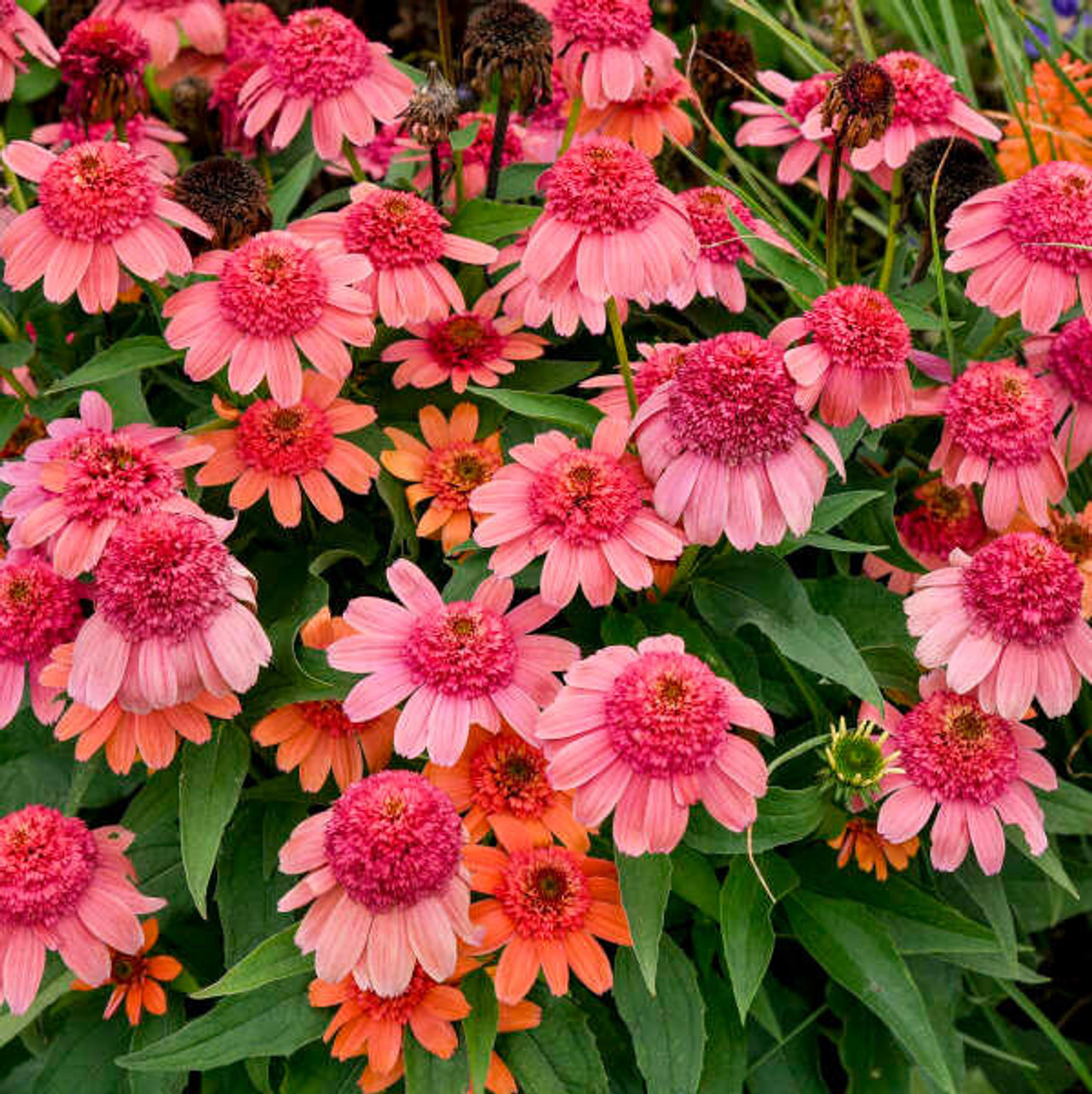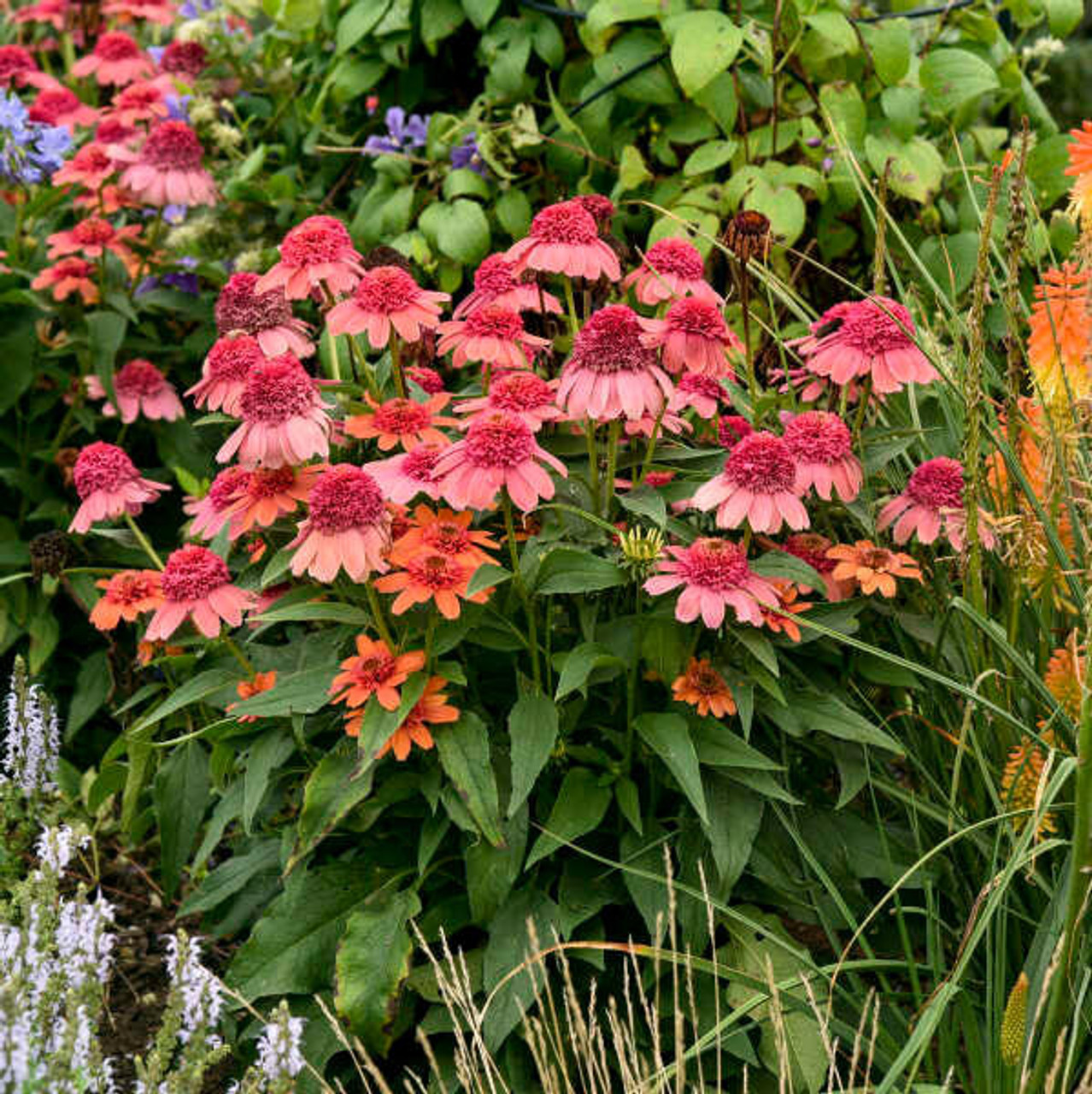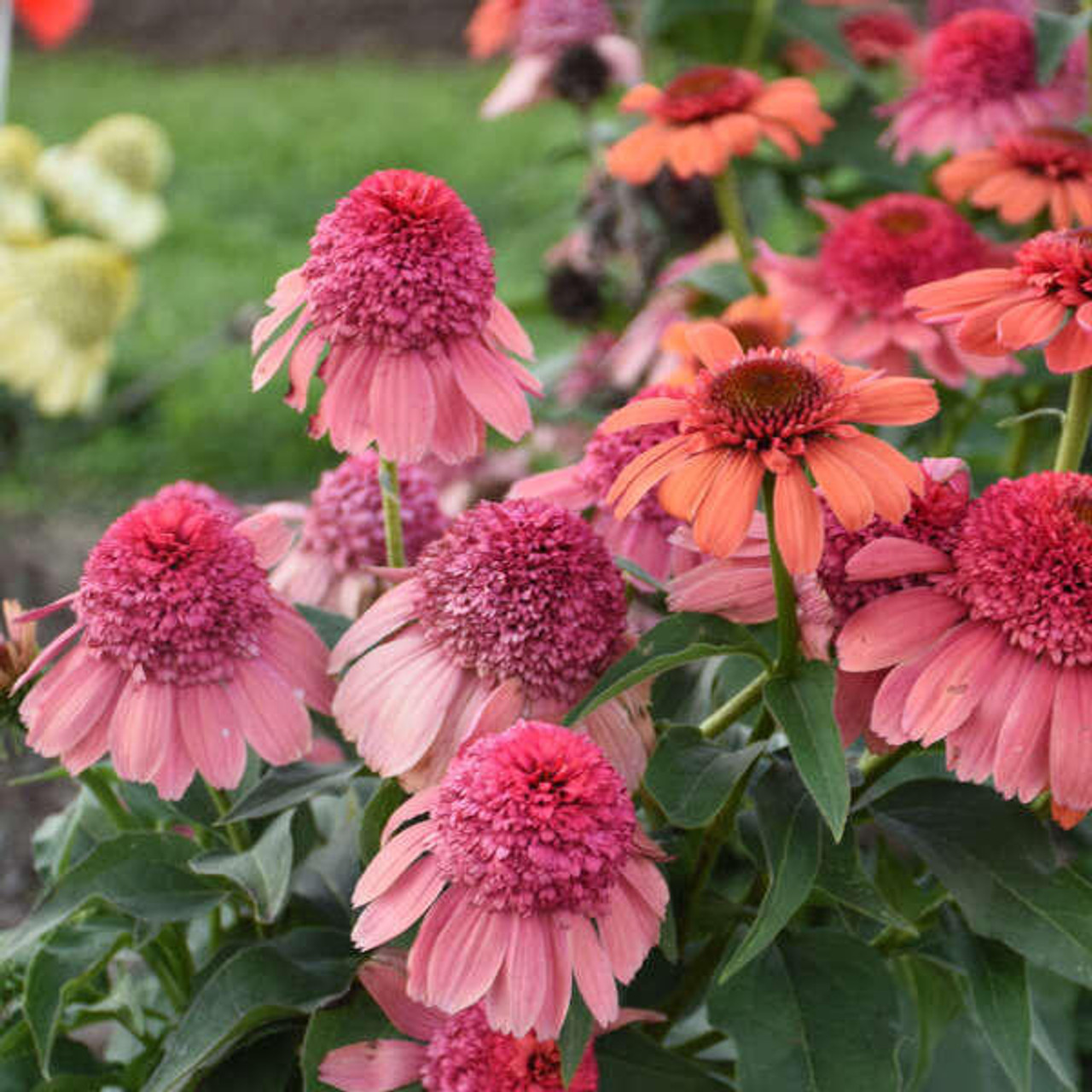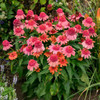Product Description
Echinacea 'Rainbow Sherbet' PPAF (30)ct Flat
DOUBLE DIPPED™ Series
Common Name: Coneflower
4½" pompom flowers with wide, overlapping ray petals. Flowers open orange before transitioning to a coral pink with matching ray petals. The color shift gives the impression of two different flower colors on the plant at once.
DOUBLE DIPPED™ Echinacea have large, fully double 4½" flowers with wide, overlapping ray petals. Each variety has substantial landscape size at 2-2½' tall, perfect for the middle of the border. Strong, well-branched stems support the large, numerous heavy flowers with ease. Mounded habit of dark green foliage. Best performance comes in full sun and well-drained soils.
Praised for their cheerful brightly colored flowers, coneflowers are a mainstay in today's garden. Be sure to leave some spent blooms on the plants in the fall because their seeds provide winter food for finches and other birds. The dried seed heads also provide architectural interest in the winter.
Coneflowers like it sunny and hot. Though they will tolerate light shade, fewer flowers will be produced, and the plants will be weakened. Light, loamy soils are best, but coneflowers will grow in any well-drained soil. Once established, they are quite drought tolerant. If properly cared for, they will form attractive colonies and will live for many years.
Height: 26.0-28.0 Inches
Spread: 18.0-24.0 Inches
Hardiness Zones: 4,5,6,7,8
Flower Color: Gold/Orange Shades, Pink shades
Foliage Color: Green shades
Full Sun to Part Shade
Low to Average Water Needs
Poor to Fertile Soil Quality
Bloomtime: Midsummer - Late Summer
Deer Resistant
Seasonal Interest: Dried Seed Heads
Growth Rate: Medium
Border Plant, Container, Cut Flower, Dried Flower, Fragrant Flowers, Mass Planting
Echinacea, commonly known as coneflower, is a popular and beloved perennial in many gardens. The 'Rainbow Sherbet' cultivar is a particularly striking variety with its large, double flowers that open orange and transition to a coral pink. This article will explore the characteristics, care requirements, and hardiness zones of Echinacea 'Rainbow Sherbet', as well as provide information on companion plants and where to purchase it.
Echinacea 'Rainbow Sherbet' is a standout variety due to its unique color-changing flowers. The blooms, reaching an average size of 4½ inches wide, open with a vibrant orange hue and gradually shift to a beautiful coral pink. This transition creates a stunning effect, often with two "scoops" of color present on the plant simultaneously. The most striking feature of 'Rainbow Sherbet' is its unique color-changing blooms, adding a dynamic element to the garden. The flowers have wide, overlapping ray petals that form a pompom-like center. The sturdy stems, reaching heights of 26-28 inches, support the large flowers with ease. The foliage is a dark green, forming a mounded habit. This cultivar reaches a mature spread of 18-24 inches.
'Rainbow Sherbet' is part of the Double Dipped™ series, developed by Walters Gardens. This series is known for its fully double flowers and substantial landscape size. It thrives in full sun and well-drained soil. Echinacea 'Rainbow Sherbet' is also deer resistant, making it a low-maintenance and attractive addition to any garden. It is a Proven Winners®, Proven Selections®, Bloomables®, Signature Garden Plants, and PROVEN WINNERS® Perennials variety. This versatile plant can be used in borders, containers, mass plantings, and even naturalized areas.
'Rainbow Sherbet' has many attractive qualities, including:
- Attracts pollinators: The flowers are a magnet for butterflies, songbirds, and hummingbirds.
- Fragrant: The flowers have a pleasant fragrance.
- Winter interest: The dried seed heads provide visual interest in the winter.
- Low flammability: This cultivar has low flammability.
- Humidity tolerant: It can tolerate humid conditions.
- Suitable for containers: It grows well in containers.
- Best for beginners: It is an easy-to-grow plant, suitable for beginner gardeners.
- Best seller: It is a popular and sought-after variety.
- Thrives in various garden settings: It can be used as a thriller in the garden, in combination containers, as a specimen plant, and to add structure to the garden.
- Good for containers and landscapes: It is suitable for both container gardening and landscaping.
- Blooms on this year's growth: It produces flowers on the current year's growth.
- Upright growth habit: It has an upright growth habit.
- Suitable for various garden styles: It is a great addition to cottage gardens, late spring or early summer gardens, summer gardens, and late summer gardens.
- Variable height and spread: It can grow to a height of 1-2 feet, 2-3 feet, or even 3-4 feet, and a spread of 1-2 feet or 2-3 feet.
Another notable cultivar in the Echinacea family is the 'Butterfly™ Rainbow Marcella'. This compact and floriferous selection produces an abundance of single, rainbow sherbet-colored blooms from early summer until frost.
Care Requirements Echinacea 'Rainbow Sherbet' is a relatively easy-to-care-for plant. This cultivar is a low-maintenance and attractive addition to any garden, requiring minimal care once established. Here is a summary of its care requirements:
- Light:
- Plant in a location that receives at least 6 hours of full sun per day. While it can tolerate some shade, it will produce fewer flowers and may become weaker.
- When day lengths are short and flowers are desired, provide 4 hours of night interruption lighting.
- Soil:
- Coneflowers prefer well-drained soil. Light, loamy soils are ideal, but they can grow in any well-drained soil type, including clay soil.
- When grown in containers, Echinacea 'Rainbow Sherbet' prefers slightly acidic soil with a pH of 5.5-6.5.
- Water:
- Proper watering is crucial for young plants to establish a strong root system and thrive in the garden. Water regularly during the first season to establish a strong root system.
- Once established, they are quite drought tolerant but will flower more profusely with regular watering.
- Fertilizer:
- Coneflowers do not require much fertilizer. Over-fertilizing can lead to spindly growth. A single application of granular garden fertilizer in the spring is sufficient.
- Avoid over-fertilizing when grown in containers, as this can lead to crown and root rot.
- Slowly reduce the level of feed going into fall as temperatures cool.
- Perform a soil test to measure soluble salt levels, which should be in the 0.5-1.0 range using the pour-through method.
- Maintenance:
- Deadheading (removing spent blooms) is not necessary but can encourage more flowers. Leaving the seed heads provides winter interest and food for birds. Cut back the foliage in early spring before new growth emerges.
- To encourage the plants to bulk up before winter, increase their day length and do not allow them to flower.
- If starting with plugs, keep them moist until they are ready to transplant, and ensure they are well-watered just before transplanting.
- Monitor soil moisture through the winter. Avoid overly wet conditions and heavy condensation.
- During exceptionally cold periods during the winter, a heavy frost blanket will help provide extra protection from the cold.
- Apply a preventive fungicide treatment in late summer to prevent root and crown rot.
- In colder regions, apply a layer of mulch (1-2 inches) after the ground freezes in fall.
- Be aware of potential pests such as whitefly, aphids, thrips, and caterpillars, as well as diseases like Botrytis, Rhizoctonia, Pythium, and Aster Yellows.
Hardiness Zones Echinacea 'Rainbow Sherbet' is hardy in USDA zones 4-8. This means it can tolerate winter temperatures as low as -30°F [-34°C].
Companion Plants Echinacea 'Rainbow Sherbet' pairs well with a variety of other sun-loving perennials. Some companion plants to consider include:
- Other Coneflowers: Combine 'Rainbow Sherbet' with other Echinacea varieties for a diverse display of colors and forms.
- Ornamental Grasses: Grasses like Panicum 'Gunsmoke', which has smoky-purple foliage, switchgrass, or fountain grass, with its graceful, arching form, add height, movement, and textural contrast to the garden.
- Perennials with Contrasting Colors: Consider plants like Perovskia 'Prime Time' (Russian sage), with its silvery foliage and lavender-blue flowers, Phlox 'Glamour Girl', with its fragrant pink flowers, Sedum 'Yellow Brick Road', with its bright yellow flowers, and Veronica 'Blue Skywalker' (speedwell), with its tall spikes of blue flowers, to create a vibrant color scheme.
- Native Plants: Butterfly weed (Asclepias), with its bright orange flowers that attract butterflies, Gaillardia (blanket flower), with its vibrant red and yellow flowers, and black-eyed Susan (Rudbeckia), with its cheerful yellow flowers and dark center cones, are all excellent native companions that thrive in similar conditions.
Thirty (30) plants per flat (or tray). Approximate Plug Measurements: 3 inches deep x 2 inches wide.
Other Details
The most important part of the plant is its root system. Healthy roots are the foundation of a healthy, vibrant plant. The type of plug container used is based on the specific needs of the plants. Perennials offered as bare root traditionally perform better when planted as bare root.Planted in a specialized mix, potted plants have well established root systems. Top growth stage will vary depending on the current life cycle and time of year when shipped. In Winter and early Spring dormant plants may be shipped. Dormant plants may be planted right away, even before the last frost date.
Most bare root varieties are field grown for at least one season, though Hemerocallis and Hosta are grown for two seasons. The bulk of the soil is removed during the harvesting process and the tops of most varieties are trimmed back to the crown. They are graded, packed in shredded aspen or sphagnum moss and stored in freezers until ready to be shipped.
See our Container Sizes and Bare Root Perennials pages for more information.
Plant information and care is provided in the Overview section, Plant Genus Page and general information is provided in the Planting Care & Guides. Additional questions can be asked on each Plant page.
Plant Spacing: Using the maximum mature spread or width of a plant to guide spacing, ensures space to grow to full size. To fill an area sooner, plant them closer together. Just remember, future thinning or transplanting may be needed.
Water: Keep a close eye on newly planted perennials, especially throughout the first growing year. Most early plant loss is due to too much or too little water!

